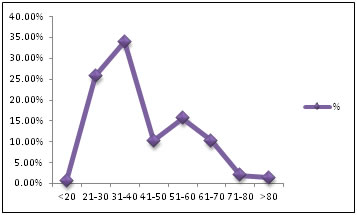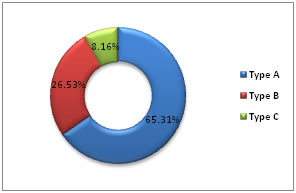Official Journals By StatPerson Publication
|
Table of Content - Volume 3 Issue 2 - August 2017
Humeral shaft fracture: A hospital based study
Narendra Maganlal Shirsat1, Tushar Prabhakar Patil2*
1Associate Professor, 2Assistant Professor, Department of Orthopedics, Dr. Ulhas Patil Medical College and Hospital, Jalgaon, Maharashtra, INDIA. Email: narendrashirsat@yahoomail.com
Abstract Background: Fractures of the shaft of the humerus account for 1% to 3% of all fractures in adults. The incidence of humeral shaft fracture is 14.5 per 100,000 per year and which is gradually increasing from the fifth decade and reaching its peak of 60 per 100,000 per year in the ninth decade. Also a minor peak is seen in the third decade. Aims and objectives: To study the humeral shaft fracture observed in tertiary care institute with reference to demographic details, mode of injury and OA classification. Materials and Method: In the present retrospective study all patients aged 16 years or more admitted in the institute with a fracture of the shaft of the humerus in the year 2014 were selected. During the study duration total 147 cases of humeral shaft fracture were admitted in institute and were selected for the study. The detail information of all the selected patients was retrieved from the case records sheets and noted on a pre-structured proforma. The details included the demographic information of patients including age, sex, area of residence, mode injury and side affected etc. Information about general and complete clinical examination was also recorded. Radiographic evaluation findings of the affected and the normal side if available were also recorded. The fracture was classified according to AO. Results: Majority of the cases were in the age group of 31-40 years (34.01%) followed by 21-30 years of age (25.85%). Majority of the patients in the study were female (55.10%). In 53.74% patients had left sided fracture. In 70.75% patients simple fall was the reason for fracture whereas a fall from height and motor vehicle accident was the mode injury in 9.52% and 8.16% patients. According to AO classification majority of the fractures (65.31%) were type A fractures followed by type B fractures (26.53%) and least in type C (8.16%). Conclusion: Thus we conclude that in the present study the humeral shaft fracture are common in the age group of 31-40 years and female sex. Simple fall was the most common reason for fracture with type A of AO classification. Key Words: Humeral shaft fracture, AO type, mode of injury.
Fractures of the shaft of the humerus account for 1% to 3% of all fractures in adults1. The incidence of humeral shaft fracture is 14.5 per 100,000 per year and which is gradually increasing from the fifth decade and reaching its peak of 60 per 100,000 per year in the ninth decade. Also a minor peak is seen in the third decade.2,3 Patients with humeral shaft fractures present with pain, deformity and swelling. The arm is shortened, with motion and crepitus on manipulation. A careful neurovascular evaluation of the limb must be documented, because the incidence of radial nerve injuries is approximately 16%.4 If indicated, Doppler pulse and compartment pressures should be checked.5,6,7 Fractures are often classified by their location: proximal third, midshaft and distal third. The widely used and accepted AO classification scheme classifies fractures by type and severity 8. Humeral shaft fractures can be managed by both operative and non-operative treatment. Traditionally, the treatment of choice was non-operative but nowadays using the Sarmiento brace as functional bracing therapy.9 Operative approaches include intramedullary nailing, plate osteosynthesis and an external fixation.10
MATERIALS AND METHOD The present retrospective study was conducted with the objective to study the epidemiology of humeral shaft fractures. The study was conducted in the department orthopedics of Dr Ulhas Patil Medical College and Hospital, Jalgaon. All patients aged 16 years or more admitted in the institute with a fracture of the shaft of the humerus in the year 2014 were selected for the study. Humeral shaft fractures were defined as the area between the surgical neck and the area immediately above the supracondylar ridge. For the purpose of study medical records of the year 2014 were studied. During the study duration total 147 cases of humeral shaft fracture were admitted in institute and were selected for the study. The detail information of all the selected patients was retrieved from the case records sheets and noted on a prestructured proforma. The details included the demographic information of patients including age, sex, area of residence, mode injury and side affected etc. Information about general and complete clinical examination was also recorded. Radiographic evaluation findings of the affected and the normal side if available were also recorded. The fracture was classified according to AO.8
The collected information was entered in Microsoft excel and was analyzed and presented with appropriate graph and tables.
RESULTS
Table 1: Age and sex distribution of patients
It was observed that majority of the cases were in the age group of 31-40 years (34.01%) followed by 21-30 years of age (25.85%). Majority of the patients in the study were female (55.10%)
Figure 1: Age distribution of cases
Table 2: Distribution of patients according to various features of fracture
It was observed that in 53.74% patients had left sided fracture and 46.26% had fracture on right side. No case was observed having bilateral fracture. In 70.75% patients simple fall was the reason for fracture whereas a fall from height and motor vehicle accident was the mode injury in 9.52% and 8.16% patients.
Table 3: Distribution of patients according to AO classification
According to AO classification majority of the fractures (65.31%) were type A fractures followed by type B fractures (26.53%) and least in type C (8.16%).
Figure 2: AO type classification
DISCUSSION The present study was conducted in the department of orthopedics of Dr. Ulhas Patil Medical College and Hospital, Jalgaon. For the purpose of study 147 cases of humeral shaft fracture were selected. It was observed that majority of the cases were in the age group of 31-40 years (34.01%) followed by 21-30 years of age (25.85%). The mean age of patients was 40.54years with standard deviation of 15.49years. The youngest patient was 19year old while the eldest patient was 87 year old. Karan C. Mahabier et al11 observed the average age of the patients in their study of 58.7 years. Mast et al12 in their retrospective study of 240 fractures of the humeral shaft, observed that 60% fractures occurred in the under-30-year age group. G. Tytherleigh-Strong3 in their series showed a bimodal distribution of the humeral shaft fractures with first peaks in the third and second peak in seventh decades. R. Ekholm et al2 reported the mean age of 62.7 years with range of 16years to 97years in their study. Thus as compared to the various authors we found slight. We observed female predominance in the present study with 55.10% humeral shaft fracture. Kiran C. Mahabier et al11 also reported female predominance in their study. R. Ekholm et al2 observed 61% patients with humeral shaft fracture were female in their study. It was observed that in 53.74% patients had left sided fracture and 46.26% had fracture on right side. No case was observed having bilateral fracture. In a study by R. Ekholm et al2 observed similar findings with 52% fracture on left side. Kiran C. Mahabier et al11 also reported left side predominance in their study. In 70.75% patients simple fall was the reason for fracture whereas a fall from height and motor vehicle accident was the mode injury in 9.52% and 8.16% patients. Kiran C. Mahabier et al11 observed that in 72% of patients the humeral shaft fracture resulted after a simple fall. According to AO classification majority of the fractures (65.31%) were type A fractures followed by type B fractures (26.53%) and least in type C (8.16%). Kiran C. Mahabier et al11 also classified cases according to AO subgroups and it showed that type A humeral shaft fractures were found most frequent (50.0% of the patients) and type C was least common (8.1% of the patients). G. Tytherleigh-Strong3 Analyzed the humeral shaft fracture distribution into AO groups and showed that 63.3% were AO type A or simple fractures, 26.2% were type B or fractures with a wedge and 10.4% were type C with the more complex patterns. R. Ekholm et al2 observed that Type-A fractures (simple) were the most common (61.0%) followed by type-B (29.6%) and type-C (9.4%) which were inconsistent with the present study.
CONCLUSION Thus we conclude that in the present study the humeral shaft fracture are common in the age group of 31-40 years and female sex. Simple fall was the most common reason for fracture with type A of AO classification.
REFERENCES
|
|
|||||||||||||||||||||||||||||||||||||||||||||||||||||||||||||||||||||||||
 Home
Home


